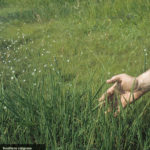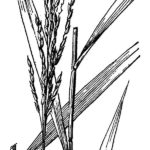Leersia hexandra
USDA, NRCS. 2018. The PLANTS Database (http://plants.usda.gov, 28 March 2018). National Plant Data Team, Greensboro, NC 27401-4901 USA.
Illustration: USDA-NRCS PLANTS Database / Hitchcock, A.S. (rev. A. Chase). 1950. Manual of the grasses of the United States. USDA Miscellaneous Publication No. 200. Washington, DC.
What is Southern Cut Grass?
Physical Characteristics
Leaves:
- Sharp edges
- Flat
- Thin
- Reducing to a point at the tip
- Rough
- 0.75 inches wide
- Up to 12 inches long
Flowers:
- Clustered
- Located at tip of branch
- Short, stiff hairs
- Short, soft hairs
- Flat
- 1-flower per spikelet
Stem:
- Wiry
- Leaning
- Hairy nodes
Roots:
- Rooting at nodes
Where Does it Grow?
Southern cut grass can be found as floating mats in water or along shorelines.
Pros and Cons of Southern Cut Grass
Southern cut grass is a valuable food source for many water birds. Submerged portions of all aquatic plants provide habitats for many micro and macro invertebrates. These invertebrates in turn are used as food by fish and other wildlife species (e.g. amphibians, reptiles, ducks, etc.). After aquatic plants die, their decomposition by bacteria and fungi provides food (called “detritus”) for many aquatic invertebrates.




